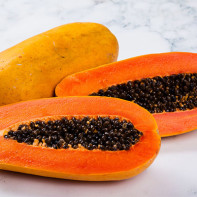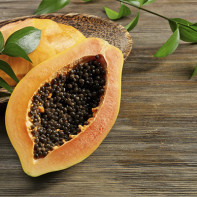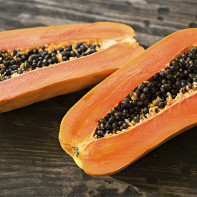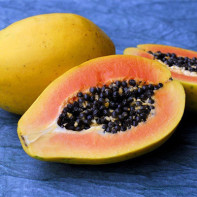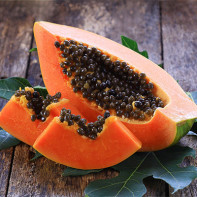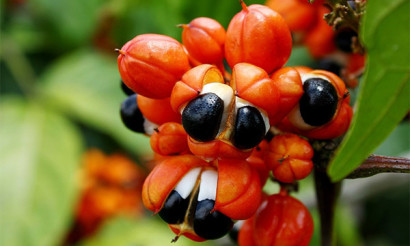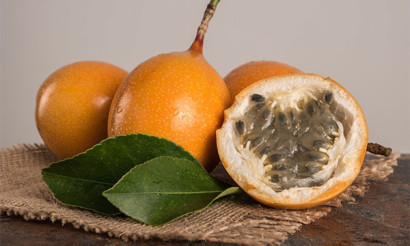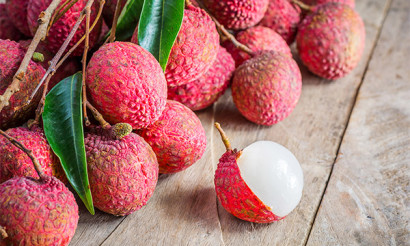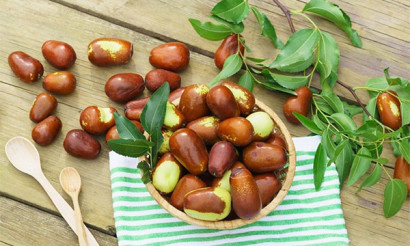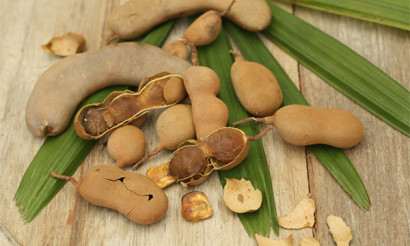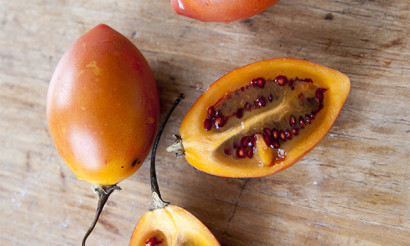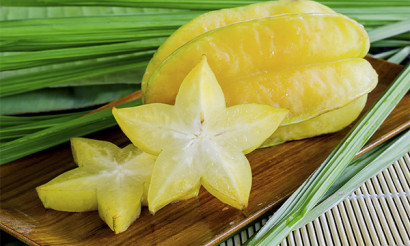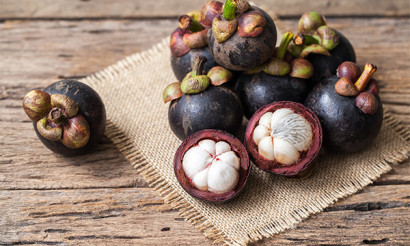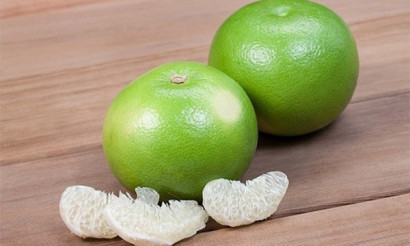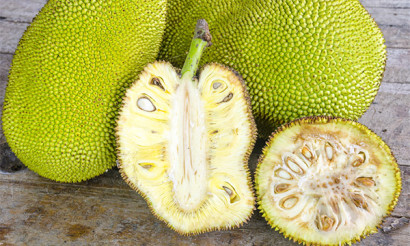Papaya fruit: composition, useful properties and contraindications
Papaya is a woody plant belonging to the Carica genus of the Dwarf family. It is a palm-shaped tree, which can reach a height of 10 meters. The plant is native to the central regions of America and Mexico, where plus temperatures prevail. The papaya is not able to exist in sub-zero temperatures, but grows perfectly well under artificially optimal conditions.
- What papaya looks like and where it grows
- Composition and Calories
- Useful properties of papaya
- General benefits
- For Women
- For Men
- In Pregnancy
- Breastfeeding
- For children
- Slimming
- Papaya Seeds: Benefits and Applications
- Benefits and Harms of Dried Papaya
- Papaya in medicine
- Diabetes
- For pancreatitis
- For Gastritis
- For Gout
- For Liver
- Papaya in cosmetology
- For Face
- For Hair
- Hazards and Contraindications
- How to Choose and Store Papaya
- Can I Freeze It
- How to Eat Papaya Properly
- How much can I eat per day?
- Can I Eat Pips?
- How to peel it
- What to make with papaya: Recipes
- Tropical Papaya Salad
- Papaya and Parma ham
- Smoothie with papaya and coconut
- Jam
- Candied papaya
- Interesting Facts about Papaya
What Papaya Looks Like and Where It Grows
Papaya is a tree with a straight trunk and no side shoots. Externally, the plant resembles a palm tree, which is why it is classified as a palm tree. The leaves fall off six months after they appear, and then new ones begin to grow. The fruits of papaya are orange or yellow fruits formed from flower stalks and up to 8 kg in size, resembling the pumpkin or melon that we are familiar with. The fruits are arranged on branches in clusters, hanging down from above, which looks very beautiful.
Papaya is widely grown in tropical countries such as Brazil, Thailand, Cuba, Kenya, Vietnam and some others. The plant is also cultivated in the surrounding areas, where there are necessary conditions for its growth. Also papaya can be found in the South Caucasus, on the Black Sea coast.
Composition and calories
Papaya, like any other fruit, has a rather low caloric value - only 48 kcal per 100 g. Thanks to the abundance of fiber in papaya, it is a dietary product that gives energy and a feeling of fullness for a long time.
Papaya fruits are tasty and juicy, but they also contain vitamins A, C, D and B, as well as fructose, glucose, iron, phosphorus, calcium, sodium, magnesium and potassium.
Useful properties of papaya
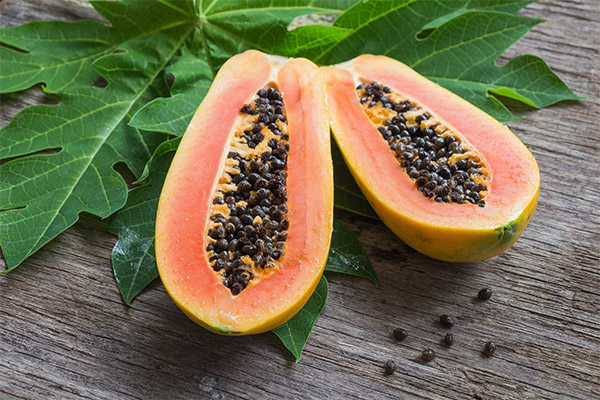
General benefits
Papaya has a number of beneficial substances for the body. Exotic fruits not only diversify the diet, but also with regular use will have the following healing properties:
- Healing various skin lesions, fighting inflammation.
- Getting rid of parasites.
- Improvement of digestion and acceleration of metabolic processes.
- Strengthening vision and immune resistance to viruses and bacteria.
- Cleansing the blood and liver from harmful substances.
- Beneficial effect on blood vessels and protection of the heart from various diseases.
Thanks to its rich composition, papaya is an excellent remedy for anemia and vitamin deficiency; besides, this fruit helps to overcome depression and strengthens immunity.
For women
Papaya is a source of many vitamins and trace elements that have a beneficial effect on the female body. This tropical fruit contains enough enzymes to stimulate metabolism, improve intestinal function, and have a mild laxative effect. This property of papaya helps in the process of losing weight, which worries quite a few women. In addition to the above-listed useful properties of papaya for women, this fruit helps to relieve menstrual pain, as well as regulates the cycle and stabilizes the onset of ovulation.
For men
Papaya contains the most important element for the male body - arginine. It is especially important to consume this exotic fruit in the process of planning the conception, as it is able to improve the performance of sperm and enhance potency.
In addition, papaya is indicated in the prevention and treatment of inflammatory diseases of the male genital sphere, as well as resisting the formation of prostate tumors. Papaya contains a lot of carbohydrates, which are necessary for men who are engaged in sports and those who are engaged in physical or hard mental work.
In Pregnancy
As we know, the most essential vitamin for pregnant women is folic acid. It is especially important to consume it in sufficient quantities at the earliest stages of pregnancy, namely, at the time of the formation of the neural tube of the fetus, in order to exclude defects in the development of the nervous system of the future child.
As papaya has a sour taste, it can easily eliminate the symptoms of toxicosis in the form of nausea and lack of appetite. Also, this exotic fruit gently regulates digestion, eliminating such a common problem among future mothers as constipation.
Papaya is also known to prevent stretch marks, because its vitamins and trace elements nourish the skin, making it firmer and more elastic. This property helps speed up the recovery of the skin after childbirth.
When breastfeeding
The lactation period is very responsible for every young mother. Any new product should be introduced to the diet carefully, in small doses, to avoid allergic reactions in the baby. As papaya is orange in color and contains a lot of vitamin C, it is quite allergenic. This should be kept in mind when consuming papaya while breastfeeding.
It is recommended that nursing women try papaya after the baby is 6 months old. In the absence of adverse reactions, this fruit is able to benefit the mother and child, as it contains many essential vitamins and minerals, and also has the ability to increase lactation.
For kids
Useful papaya is not only for adults, but also for children. In the absence of allergies, this fruit can strengthen the immune system, improve digestion and prevent constipation. Children should be given exotic fruits before they reach the age of 8 months, starting with a small piece and gradually increasing it to 50-100 grams per day. Small children need to puree the fruit, you can use a blender or mash papaya with a fork. In any case, before introducing such an exotic fruit as papaya, it is necessary to consult a pediatrician, as in some cases it may be strictly contraindicated.
When losing weight
Papaya is the fruit with the highest content of nutrients. The fact that it is quite low in calories (only 48 kcal per 100 g) makes this exotic fruit suitable for consumption during weight loss.
Antioxidants contained in papaya help cleanse the body of toxins and harmful substances, and a sufficient amount of fiber contributes to comfortable digestion. Papaya contains carbohydrates in the form of fructose, which keep energy at the right level, which allows you to actively exercise, the most important part of the weight loss process.
To achieve fast weight loss results, you should consume papaya fruits for breakfast and as a snack between main meals. It is enough to eat 50 to 200 g of papaya a day to get all the health benefits of papaya that are important for weight loss. In addition to consumption in its whole form, papaya can be used to make dried fruits, various desserts and smoothies, adding it to any fruit and berries.
Papaya seeds: benefits and uses
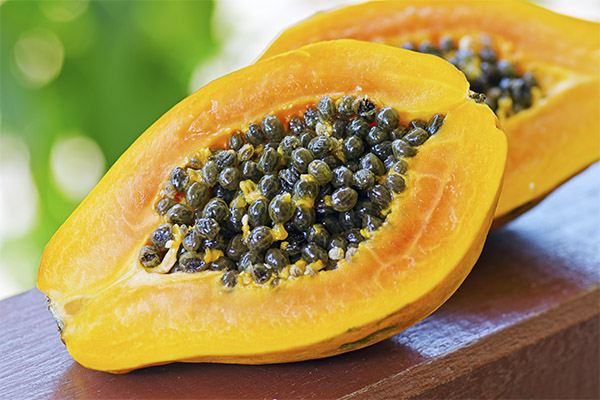
Many people just throw away papaya seeds, forgetting or not knowing that they too can bring significant benefits to the body. The seeds of this fruit have an interesting taste, reminiscent of mustard or black pepper. For medicinal purposes, half a teaspoon of papaya seeds per day should be consumed. Their benefits:
- Contribute to overcoming cancer;
- have antibacterial and antiparasitic properties;
- Help in treatment of liver diseases, including cirrhosis;
- Increase overall immunity;
- contribute to better digestion of protein.
In order to get the most useful properties of papaya seeds without eating them raw, you can use the following recipe for preparing a folk remedy for many ailments. Grind 4-6 seeds in a mortar, add a tablespoon of lime and infuse for half an hour. Use the composition twice a day for one month. This composition is especially useful for patients suffering from cirrhosis of the liver and other diseases associated with the malfunction of this organ.
The benefits and harms of dried papaya
From papaya prepare delicious and useful dried fruits, which also retain all the useful properties of the original product. You can make dried papaya yourself or buy it in a store, where it is sold in the form of long sticks by weight or in individual packages.
Dried papaya contains a large amount of useful substances. So, it is enough to eat only 50 grams of these dried fruits a day to saturate the body with vitamin A, as well as some other vitamins and trace elements such as magnesium, potassium, copper, etc.
The vitamins E, K, B5 and B9 in dried papaya support the nervous system. They contribute to the proper functioning of the brain and are especially useful during periods of hard mental work and nervous overexertion.
Sufficient amounts of dietary fiber (fiber) can improve blood composition and lower the level of harmful cholesterol in the blood. Also in the dried fruits of papaya there is a large amount of carotenoids, especially useful for eyesight and cardiovascular system. But the vitamin B content of dried papaya fruit is at a low level, unlike fresh fruit.
Papaya in medicine
Such an exotic fruit as papaya is able to trigger the most important processes in the body - purification, general recovery and cure a number of diseases. Due to the high value of the fruit it is recommended to include it in the diet in the presence of certain health problems.

For diabetes
Papaya is one of the fruits that can be eaten with diabetes. The exotic delicacy has a low glycemic index, which allows you to maintain a constant blood sugar level. The benefits of papaya for patients with type 1 and type 2 diabetes lie in increasing blood insulin levels, protecting liver and pancreatic cells, and its antioxidant effect. Papaya is also useful for diabetics who watch their weight (a topical problem for diabetes), as it contains few calories (48 kcal per 100 grams) and enough fiber.
Diabetics need to be very careful about eating any fruit, including papaya. Diabetics need qualified medical care and medication, otherwise complications such as gangrene, hypoglycemia, nephropathy and even cancer can occur. That is why it is extremely important to continuously monitor the condition of the body, as well as with caution consume sugar-containing products. The benefit of papaya for diabetics lies in the large number of vitamins and trace elements contained in this fruit: vitamins A, C, iron, potassium, etc. Since the diet of diabetics is strictly limited, including papaya in the menu will only bring positive results.
For pancreatitis
Not all fruits can be eaten with pancreatitis. The choice of a particular product in pancreatitis should be based on the phase in which the disease is - acute, chronic remission or chronic exacerbation. In the first two phases, eating papaya, like any other fresh fruit and berries, is not prohibited, but in chronic exacerbations such delicacies have to be abandoned.
Consumption of papaya is possible only if there is no pain, indicating that the disease is in remission. Fruits and berries are important in pancreatitis, because they make up for the lack of useful substances in the body, while relieving pancreatic inflammation. However, it is still desirable to treat papaya thermally, in order to avoid the resumption of the acute phase of the disease.
For gastritis
Papaya is not recommended to eat to patients with gastritis, who are in the acute stage of this disease, as well as in the erosive form and increased acidity. This is explained by the property of papaya to irritate the walls of the intestine and provoke the secretion of gastric juice.
During remission it is allowed to eat some fruits, including papaya. However, it is advisable to include papaya in a limited amount, up to 50 g per day, paying attention to your own health, and if there are any side effects, stop eating the fruit for a while.
In case of gout
Papaya can and should be included in the diet for gout. This fruit has anti-inflammatory properties, thanks to which it helps to overcome the disease. For therapeutic purposes, it is recommended to eat 100-200 grams of fresh papaya per day or 50 grams of dried fruit for gout.
For the liver
Overcoming most liver problems will help papaya seeds. This is a very valuable product used in Chinese folk medicine since ancient times. Papaya seeds have the property to remove toxins from the liver, as well as to repair damaged cells of the organ.
Detoxification of the liver with the help of papaya seeds is not difficult. To do this, you need to consume a tablespoon of seeds a day, chew thoroughly and drink liquid. Papaya is also known for its benefits for fatty liver.
Papaya in cosmetology
Papaya is widely used in the field of cosmetology, which is due to its surprisingly useful properties. Rich in vitamins C, A and several micronutrients, papaya is a particularly valuable fruit for skin and hair health.

Some cosmetic products use papaya extract, which has anti-inflammatory and regenerating effects. Papaya is also known for its ability to stimulate metabolic processes in cells, which prevents premature aging of the skin and also helps to eliminate age spots, warts and calluses.
Papaya seeds are included in some scrubs, gels, peels and soaps with exfoliating effect. On top of that, papaya extract is found in products against unwanted hair growth and is often used in creams designed to take care of the skin after depilation.
Let's look at a few beauty recipes using papaya.
For the face
- Exfoliating peeling mask. To prepare the mask, you will need 2 tbsp of papaya puree, 1.5 tbsp of oatmeal, 1 tsp of sugar. All the ingredients should be mixed and applied to the skin, leave the mask for 15 minutes and then rinse off with water.
- Moisturizing mask is prepared as follows: Mix 1 tbsp. of grated papaya with 1 tbsp. of avocado (also mashed) and 1 tbsp. of olive oil. The resulting mixture to keep on the face for half an hour, then rinse with water.
- Whitening mask for the face. To prepare it, take 1 tbsp. of mashed papaya, the same amount of natural live yoghurt, 1 tsp. of lemon juice and 0,5 tsp. of olive or other vegetable oil. Mix all the ingredients and apply to the face, rinse off after 15-20 minutes.
- Purifying and anti-inflammatory mask based on papaya oil: take 5 ml of oil, mix with 10 g of black clay and 20 g of gelatin. Mix the ingredients, apply to the face, wash off after half an hour. The result is clean skin without black dots, inflammation and pimples.
For hair
- A mask of papaya (half a ripe fruit), two yolks, natural yogurt (2 tablespoons) is an excellent remedy for dry hair. Beat the above ingredients with a whisk or in a blender and apply to the hair. Hold the mask for 45 minutes under a cap and towel. Such a mask makes the hair moisturized and shiny, and also prevents split ends and other damage.
- For blonde-haired girls this mask will do: 2 tbsp. puree of papaya, 0,5 tbsp. linseed oil, 2 tbsp. honey, 1-2 tbsp. oat flour and a few drops of sandalwood oil. Mix the ingredients, apply the resulting composition by massaging the hair roots and distribute over the entire length. Hold the mask for about one hour, then wash off with warm water.
Papaya oil makes the hair stronger and healthier, as well as stimulates hair growth. You can buy papaya oil at the drugstore. Its composition includes such auxiliaries as palmitic, oleic and stearic acids, which are also beneficial for the beauty and health of the hair.
Harms and contraindications
Although papaya has a huge list of beneficial properties, in some cases it can cause harm to the body. First of all, the danger arises in case of overdose. Due to its alkaloid content, heartburn, nausea, or diarrhea can occur if you consume papaya in excess. Do not consume unripe fruits, as they can cause gastrointestinal upset and inflammation of the stomach and esophagus walls.
It is not safe to eat papaya for some diseases:
- Individual intolerance to the fruit;
- Frequent digestive disorders;
- pancreatic diseases;
- Peptic ulcer or acute gastritis.
In order not to harm the body and not to make it worse for yourself, if you have any significant health problems, you should first consult a doctor, and then start to introduce the exotic fruit in your diet. To check whether you are allergic to papaya or not, you just need to try a piece of fruit and analyze your condition after 2 to 4 hours. If no signs of allergy appeared, then the fruit can be eaten.
How to choose and store papaya
When choosing a papaya, you need to be guided by the following rules:
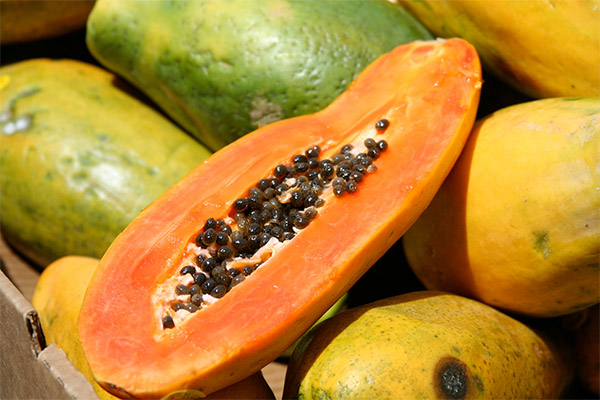
- The fruit should be smooth, not battered, not too soft or too hard.
- The color of a ripe papaya is yellow, close to orange. But greenish and dull shades indicate that the fruit is either not ripe or has grown in unfavorable conditions and has very poor taste.
- The skin should be thin and the flesh underneath should be soft but not squishy. Fruit that is too soft tends to be fibrous and not very tasty.
- The area where the "tail" of the fruit was attached is hard in a quality fruit and does not fall through, and gives off a pleasant fruity flavor.
Once the papaya is brought home, you can eat it right away (the most appropriate option) or make preparations with it. It is acceptable to store sliced papaya for 3 to 4 days. The whole fruit will keep much longer, but care must be taken to keep the fruit out of the sun and away from liquids.
If you bought an unripe papaya, there is no need to throw it away, because even such a fruit can be saved. For ripening, you can put the papaya in a room (not in the refrigerator), next to a ripe banana. Turn the fruit periodically so that it ripens evenly. Once the papaya is a deep yellow-orange color, it can be considered ripe.
The best way to store papaya for a long time is to dry it. To do this, peel the papaya's skin and seeds, cut it into small blocks and leave it to dry, avoiding direct sunlight and open air.
Can I freeze it
Papaya is a fruit that should not be frozen. First of all, few nutrients remain in the frozen fruit, and secondly, the taste of this fruit suffers significantly when frozen.
How to eat papaya properly
Sweet and ripe papaya is a tasty treat for children and adults. This fruit can be eaten both fresh and as part of various dishes and drinks. Before eating the papaya you should peel it, remove the seeds and cut it into cubes or slices. If the fruit is too soft you can eat it with a spoon without peeling it.
You can heat treat papaya. They can be baked, boiled, and even fried. Papaya can be added to salty and sweet dishes, because the fruit has a neutral taste and is not too sweet. There are a lot of recipes for salads, second courses, baked goods and drinks with the addition of papaya, which will be discussed below.
How much you can eat per day
In the absence of allergies, it is allowed to eat papaya every day. As a rule, it is enough to eat at least a slice of this fruit a day to get all its useful components. In some cases it is possible to consume papaya in large quantities, for example, there is a diet on this tropical fruit or unloading days, when the amount of papaya eaten per day reaches 1-2 large fruits. In any case, the amount of papaya that can be eaten per day should depend on the individual characteristics of the person, the presence of those or other diseases and the desired result of eating this fruit.
Is it possible to eat papaya seeds?
Not only the pulp, but also the papaya seeds have a beneficial effect on the body. However, you should take into consideration that you should eat only small amounts of seeds - 1-2 teaspoons a day is enough to get all their beneficial properties.
Papaya seeds are rich in polyphenols and flavonoids - compounds with antioxidant effect that help improve all health indicators, eliminate oxidative stress and related chronic diseases.
Monounsaturated fatty acids, which are present in sufficient quantities in papaya seeds, are very useful for the cardiovascular system and the body in general. And the abundance of fiber in the seeds has a beneficial effect on the intestines, reduces the level of harmful cholesterol in the blood, preventing the occurrence of strokes, heart attacks, diabetes and obesity.
How to peel
Peeling papaya is not difficult if a really ripe and quality fruit has been chosen. To peel a papaya, you need to cut it in half lengthwise, then remove the seeds and peel the skin with a knife, and then you can cut it into cubes or slices. If the fruit is too ripe and soft, it will be difficult to peel and slice it. In this case, it is enough to cut the papaya in half, remove the seeds and eat the pulp with a spoon.
What you can make from papaya: recipes
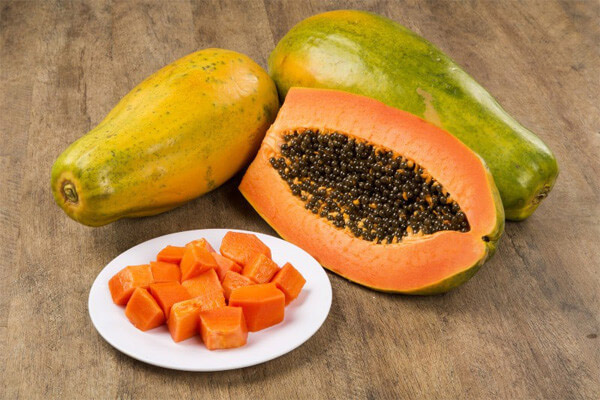
Tropical papaya salad
Dice 250g of peeled and seeded papaya, add the same amount of pineapple, cherimoya and lychee (all cut equally). Mix all the fruit and leave in the fridge for 2-3 hours, then put lettuce leaves (lettuce will do) on a plate, dress the fruit with natural yoghurt and a teaspoon of lemon juice, and arrange on top of the leaves.
Papaya with Parma ham
An amazing dish will be tasted by true gourmets. You need to take one ripe (but not too ripe, so as not to be too sweet) papaya fruit, cut in half, remove the seeds and cut into slices. Then put it on the plates, sprinkle with black pepper and lemon juice, lay the Parma ham sliced into strips on top of the papaya, decorate the dish with cheese and walnuts.
Smoothie with papaya and coconut
To make a refreshing and nutritious drink you will need 150g of papaya, 15g of coconut flakes, 125g of any berries, 125g of natural yoghurt. Whisk all the ingredients in a blender, adding a few spoons of water if the consistency is too thick.
Jam
Tropical fruits make an interesting and tasty jam, which can be a substitute for the usual dessert of strawberries, raspberries and other berries. To cook papaya jam for the winter, you need to take ripe fruit, peel them from the skin and seeds, cut into cubes, pour sugar (in a 1:1 ratio). After the fruit will give juice, you can put the future jam on low heat. After boiling, remove from the stove and wait 1-2 hours. Then bring it to a boil again, add lemon juice (2 tbsp per liter of jam), cook for about half an hour until the foaming stops. Pour the ready jam in dry sterilized jars and seal.
Candied papayas
Candied papaya is a favorite tea treat for many. But you don't have to buy candied papaya in a store, you can make it yourself. To do this, prepare the papaya: take a fairly ripe, but not overripe fruit, peel it from the skin and seeds, cut into strips or cubes. Cook sugar syrup separately, put papaya and a little lemon juice in it, and cook all together for about 5-7 minutes. Then take it off the stove, cool it down and simmer for another 5 minutes. Repeat this 3 times, then put the papaya in a colander or sieve until the syrup has completely drained (this will take at least an hour). Afterwards, you can sprinkle the candied papaya with powdered sugar and enjoy the amazing dessert.
Interesting facts about papaya
- In its chemical composition and taste, papaya is similar to melon, due to which some even call this plant a melon tree.
- The plant is called the "bread tree" because when you bake it, you can smell the aroma of freshly baked bread.
- Unripe fruit is strictly contraindicated for pregnant women, as green papaya's constituent substances can cause pregnancy termination.
- Papaya fruits can reach unbelievably big size - up to 7 kg. But this refers mostly to wild plants, while cultivated papaya yields fruits up to 3 kg.
- A single fruit may contain about a thousand seeds.
- Papaya stems and bark are used for making ropes, which are quite strong and durable.
- The most valuable substance in papaya is papain. This substance is very useful for the body, as it helps to prevent and cure many diseases.
- Papaya is able to make fingerprints less noticeable. For example, prolonged contact with papaya pulp erases fingerprints over time.
- In Florida, women use papaya leaves in their households. You can use them to wash almost any stain from fabric.
- In Thailand, recipes for dishes with green papaya are popular. Unripe fruits are added to salads and hot dishes.
«Important: All information on this site is provided for informational purposes only. for informational purposes only. Consult with your health care professional before using any recommendations. specialist before using any of the recommendations. Neither the editors nor the authors shall be held liable for any possible harm caused by materials."

